The point-hyperplane design 2-(15, 7, 3)
One can construct a design by the incidence between points and hyperplanes of the
projective geometry PG(3,2). In this design you have 15 points as well as 15 blocks.
(hyperplanes). Every hyperplane contains 7 points and each pair of points is
contained in exactly 3 hyperplanes.
This design can be visualized by a tetrahedron:
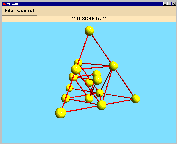
The steps of construction are the following:
| |
|
|
|
| First you take the vectors of weight 1 (0001, 0010, 0100 and 1000) as vertices of a tetrahedron. |
Then you can add every pair of these vertices, so you get 6 vectors of weight
2 and put them in the middle of the edges of the tetrahedron (this procedure gives
an octahedron). |
The sum of 3 tetrahedron vertices gives the central point of the corresponding
face (you get 4 of them; they form the dual tetrahedron of the original one). |
And last but not least you put the all-one vector 1111 right into the
middle of the tetrahedron. |
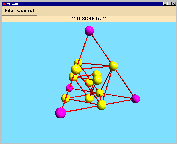
|
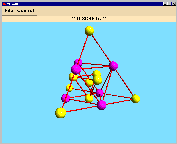
|
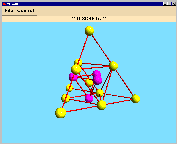
|
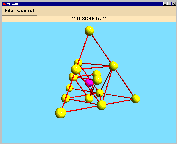
|
The "recipe" for the group selection "solids" in DISCRETA is the following:
- take a tetrahedron
- take the edge midpoints of the tetrahedron (by pressing "Tetrahedron",
"choose", "midpoints of edges" and again "choose") - this gives an inscribed octahedron
- take the dual (which is also a tetrahedron, whose vertices are the midpoints
of the faces of the original tetrahedron) by pressing "Tetrahedron", "choose",
"dual" and "choose"
- last thing to do is to choose "add central point"
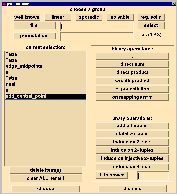
The results of each single step is coloured in pink at the pictures above.
This construction yields a group derived from the symmetry group A_4 (group order:
12) of the
tetrahedron (the group is induced on the edge midpoints and on the dual tetrahedron,
and finally you can add a fixpoint such that you get a group on 15 points). Under
the action of this group you receive by computations with DISCRETA 6 2-(15, 7,
3) designs (some of them are isomorphic under a larger group). More
information on them you can read in this
report.
One of the designs is visualized below: you get the following orbit representants coloured
in pink (with the corresponding orbit length). Adding the orbit lengths, we get
15 blocks as recommended.
| |
|
|
|
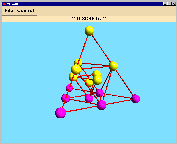
|
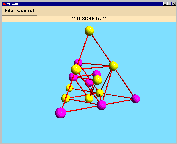
|
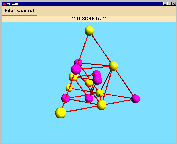
|
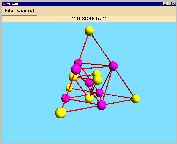
|
| orbit length: 4 |
orbit length: 6 |
orbit length: 4 |
orbit length: 1 |
The projective geometry PG(3,2):
When we consider the 2-subsets and the 3-subsets of the 15 points above
and fix lambda=1,
we receive the following Kramer-Mesner matrix w.r.t. the action of the same
group(size: 13x46):
3 3 1 3 3 0 0 0 0 0 0 0 0 0 0 0 0 0 0 0 0 0 0 0 0 0 0 0 0 0 0 0 0 0 0 0 0 0 0 0 0 0 0 0 0 0
0 3 1 0 0 3 3 3 0 0 0 0 0 0 0 0 0 0 0 0 0 0 0 0 0 0 0 0 0 0 0 0 0 0 0 0 0 0 0 0 0 0 0 0 0 0
0 0 0 2 2 0 2 2 4 1 0 0 0 0 0 0 0 0 0 0 0 0 0 0 0 0 0 0 0 0 0 0 0 0 0 0 0 0 0 0 0 0 0 0 0 0
0 0 0 0 0 1 0 0 0 0 2 1 2 2 1 2 2 0 0 0 0 0 0 0 0 0 0 0 0 0 0 0 0 0 0 0 0 0 0 0 0 0 0 0 0 0
0 0 0 0 0 0 1 0 0 0 0 1 1 1 0 0 0 1 2 1 1 1 1 1 1 0 0 0 0 0 0 0 0 0 0 0 0 0 0 0 0 0 0 0 0 0
0 0 0 0 0 0 0 1 0 0 0 0 1 1 1 0 0 1 0 1 1 0 0 0 0 2 1 1 1 1 0 0 0 0 0 0 0 0 0 0 0 0 0 0 0 0
0 0 1 0 0 0 0 0 0 0 0 0 0 0 0 3 0 0 0 0 0 3 0 0 0 0 3 0 0 0 3 0 0 0 0 0 0 0 0 0 0 0 0 0 0 0
0 1 0 0 0 0 0 0 0 0 0 0 0 0 0 1 2 0 0 0 0 0 1 1 1 0 0 1 1 1 1 2 0 0 0 0 0 0 0 0 0 0 0 0 0 0
0 0 0 0 0 0 0 0 1 0 0 0 0 0 0 0 0 1 1 1 0 0 0 0 0 1 0 0 0 0 0 0 1 1 1 1 1 1 1 1 0 0 0 0 0 0
0 0 0 0 0 0 0 0 0 1 0 0 0 0 0 0 0 0 0 0 4 0 0 0 0 0 0 0 0 0 0 0 0 2 0 2 0 0 0 0 4 0 0 0 0 0
0 0 0 0 1 0 0 0 0 0 0 0 0 0 0 0 0 0 0 0 0 1 1 0 0 0 0 1 1 0 0 0 0 0 0 0 1 2 1 0 1 1 1 1 0 0
0 0 0 1 0 0 0 0 0 0 0 0 0 0 0 0 0 0 0 0 0 0 0 1 1 0 1 0 0 1 0 0 0 0 0 0 1 0 1 2 1 0 1 1 1 0
1 0 0 0 0 0 0 0 0 0 0 0 0 0 0 0 0 0 0 0 0 0 0 0 0 0 0 0 0 0 2 2 0 0 0 0 0 0 0 0 0 1 2 2 1 2
It is very interesting that we can visualize the projective plane PG(3,2)
with this construction of the tetrahedron - it is a Steiner triple system on 15
points. By solving the corresponding matrix equation, one gets 12 designs with DISCRETA,
the orbits of one of them are the following (see also the
report):
| |
|
|
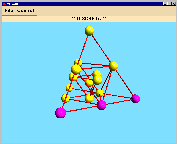
|
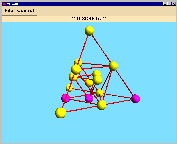
|
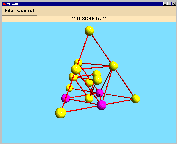
|
| orbit length: 6 |
orbit length: 12 |
orbit length: 4 |
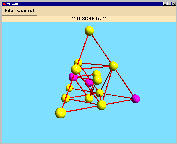
|
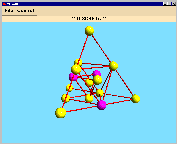
|
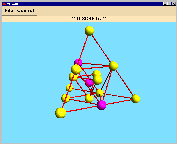
|
| orbit length: 4 |
orbit length: 6 |
orbit length: 3 |
Therefore we get 35 blocks. It is a very interesting remark that all the blocks of the
point-hyperplane design above consist of Fano planes whose blocks are exactly
blocks from the PG(3,2)!
To the DISCRETA homepage.
Back to the homepage of Evi Haberberger.
To the homepage of Lehrstuhl II.
Last updated: June 16, 1999.












